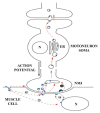Fragment C of tetanus toxin: new insights into its neuronal signaling pathway
- PMID: 22837670
- PMCID: PMC3397502
- DOI: 10.3390/ijms13066883
Fragment C of tetanus toxin: new insights into its neuronal signaling pathway
Abstract
When Clostridium tetani was discovered and identified as a Gram-positive anaerobic bacterium of the genus Clostridium, the possibility of turning its toxin into a valuable biological carrier to ameliorate neurodegenerative processes was inconceivable. However, the non-toxic carboxy-terminal fragment of the tetanus toxin heavy chain (fragment C) can be retrogradely transported to the central nervous system; therefore, fragment C has been used as a valuable biological carrier of neurotrophic factors to ameliorate neurodegenerative processes. More recently, the neuroprotective properties of fragment C have also been described in vitro and in vivo, involving the activation of Akt kinase and extracellular signal-regulated kinase (ERK) signaling cascades through neurotrophin tyrosine kinase (Trk) receptors. Although the precise mechanism of the molecular internalization of fragment C in neuronal cells remains unknown, fragment C could be internalized and translocated into the neuronal cytosol through a clathrin-mediated pathway dependent on proteins, such as dynamin and AP-2. In this review, the origins, molecular properties and possible signaling pathways of fragment C are reviewed to understand the biochemical characteristics of its intracellular and synaptic transport.
Keywords: Trk receptors; clathrin-mediated pathway; dynamin; fragment C; neurotrophin; tetanus toxin.
Figures







Similar articles
-
C-terminal fragment of tetanus toxin heavy chain activates Akt and MEK/ERK signalling pathways in a Trk receptor-dependent manner in cultured cortical neurons.Biochem J. 2003 Jul 15;373(Pt 2):613-20. doi: 10.1042/BJ20030333. Biochem J. 2003. PMID: 12710887 Free PMC article.
-
HC fragment (C-terminal portion of the heavy chain) of tetanus toxin activates protein kinase C isoforms and phosphoproteins involved in signal transduction.Biochem J. 2001 May 15;356(Pt 1):97-103. doi: 10.1042/0264-6021:3560097. Biochem J. 2001. PMID: 11336640 Free PMC article.
-
Structure of tetanus toxin: the arrangement of papain digestion products within the heavy chain-light chain framework of extracellular toxin.Biochim Biophys Acta. 1981 Mar 27;668(1):141-8. doi: 10.1016/0005-2795(81)90157-4. Biochim Biophys Acta. 1981. PMID: 7016194
-
The elusive compass of clostridial neurotoxins: deciding when and where to go?Curr Top Microbiol Immunol. 2013;364:91-113. doi: 10.1007/978-3-642-33570-9_5. Curr Top Microbiol Immunol. 2013. PMID: 23239350 Review.
-
Insights into Clostridium tetani: From genome to bioreactors.Biotechnol Adv. 2022 Jan-Feb;54:107781. doi: 10.1016/j.biotechadv.2021.107781. Epub 2021 May 23. Biotechnol Adv. 2022. PMID: 34029623 Review.
Cited by
-
siRNA screen of ES cell-derived motor neurons identifies novel regulators of tetanus toxin and neurotrophin receptor trafficking.Front Cell Neurosci. 2014 May 20;8:140. doi: 10.3389/fncel.2014.00140. eCollection 2014. Front Cell Neurosci. 2014. PMID: 24904285 Free PMC article.
-
Tetanus Toxin Fragment C: Structure, Drug Discovery Research and Production.Pharmaceuticals (Basel). 2022 Jun 17;15(6):756. doi: 10.3390/ph15060756. Pharmaceuticals (Basel). 2022. PMID: 35745675 Free PMC article. Review.
-
Kinase-dependent Regulation of Monoamine Neurotransmitter Transporters.Pharmacol Rev. 2016 Oct;68(4):888-953. doi: 10.1124/pr.115.012260. Pharmacol Rev. 2016. PMID: 27591044 Free PMC article. Review.
-
Confocal Endomicroscopy of Neuromuscular Junctions Stained with Physiologically Inert Protein Fragments of Tetanus Toxin.Biomolecules. 2021 Oct 12;11(10):1499. doi: 10.3390/biom11101499. Biomolecules. 2021. PMID: 34680132 Free PMC article.
-
Preconditioning With Intermittent Hypobaric Hypoxia Attenuates Stroke Damage and Modulates Endocytosis in Residual Neurons.Front Neurol. 2021 Dec 15;12:750908. doi: 10.3389/fneur.2021.750908. eCollection 2021. Front Neurol. 2021. PMID: 34975719 Free PMC article.
References
-
- Johnson J.L., Francis G. Taxonomy of the clostridia: Ribosomal ribonucleic acid homologies among the species. J. Gen. Microbiol. 1975;88:229–244. - PubMed
-
- Johnson E.A. Clostridial toxins as therapeutic agents: Benefits of natures’s most toxic proteins. Annu. Rev. Microbiol. 1999;53:551–575. - PubMed
Publication types
MeSH terms
Substances
LinkOut - more resources
Full Text Sources
Other Literature Sources
Medical
Research Materials
Miscellaneous

